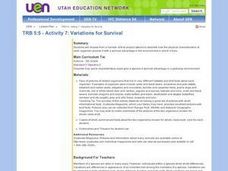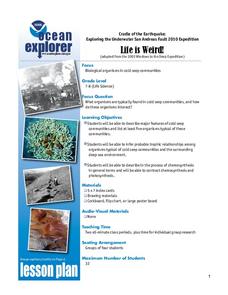Curated OER
Body by Design: Form and Function
Students study symbiosis and its association in nature. In this organisms lesson plan students divide into groups and research organisms that have a symbiotic relationship.
Curated OER
The Void Filled by Nonprofits
High schoolers examine the significance of nonprofit organizations in a democratic society. They conduct research on a selected nonprofit organization, complete a questionnaire, and present their findings to the class.
Curated OER
Jewel of the Earth
Pupils investigate several organisms, set sticky traps to collect them, and attempt to identify and classify them using a variety of sources. The origins of the organisms are traced and their adaptive features examined.
Curated OER
What Becomes of Cell?
Sixth graders analyze and compare a cell's tissues, organs and organ systems. They watch a video reviewing the body systems and design poster boards showing their functions.
Curated OER
Environmental Conditions: Friend or Foe
Students research and answer questions on how organisms are classified and how their needs are met through their environment. They work in small groups and create a poster, chart, rap, PowerPoint, or brochure demonstrating how organisms...
Curated OER
Do You Have the Guts?
Seventh graders Name and locate the major internal organs of the human body and the frog. Students virtually dissect a frog and compare organs to the human organs. Students draw illustrations of their learnings.
Curated OER
Exploring Nonprofits
Students research nonprofit organizations. In this philanthropy lesson, students use the Yellow Pages to identify nonprofit organizations and graph the organizations according to category.
Curated OER
Variations for Survival
Fifth graders examine two related organisms that live in different environments and compare how the physical characteristics of each organism provided it with survival advantages unique to its own environment.
Curated OER
The Internal Anatomy of the Grasshopper
Sixth graders explore the internal organs of grasshoppers. They determine the function of the organs through a dissection activity.
Curated OER
Ecosystems: What Are They and How Do They Work?
Students explore the characteristics of major ecosystems, the interactions of the organisms within the systems, and the effects of humans on the system. Both living and non-living components are examined in this five lesson unit.
Curated OER
Pathway to Philanthropy
Students implement a plan to carry out a service project with a nonprofit organization. In this philanthropy lesson, students use a decision-making model to choose a local organization to work with and keep a journal of the service...
Curated OER
I Need Air
Students examine and research the organs of the respiratory system. They participate in a vocabulary card matching game, create a graphic organizer, and participate in an experiment titled, Floating on Air.
Curated OER
Human Body Corporation
Learners communicate about the human body. They write letters to simulate the Human Body Corporation. They select an organ and explain its importance in the human body including its name, systems, functions, and how the functions are...
Curated OER
How Hot is Too Hot?
Fifth graders use the scientific method to conduct experiments on the temperature effects on organisms. In this temperature effects on organisms lesson plan, 5th graders observe and record the hatching or the developing of organisms into...
Curated OER
Biochemistry Detectives
High schoolers explore the process of chemosynthesis and relate it to the biological communities in cold seeps. In this biochemistry instructional activity students interpret analyses of enzyme activity and draw inferences about...
Curated OER
PULSE: A STOMP Odyssey (6-8)
Students examine how non-profit organizations support the arts. In this non-profit lesson, students learn how foundations provide funding that supports arts in a community which contributes to the common good. They watch the movie...
Curated OER
The Changing Coral Reef Community Game
Students examine organisms that inhabit the coral reefs and their living requirements. In this coral reef lesson students chart population changes and play a game.
Curated OER
Populations – The Survival of the Fittest (Part 1)
Students explain in their own words why organisms live together. In this biology instructional activity, students model what happens to organisms if their environment changes. They explain the importance of evolution.
Curated OER
Human Body Quest
In this biology worksheet, students describe and name their organ system selected and its major functions. Then they create a diagram of their body system with the major parts and organs labeled. Students also write facts about their...
Curated OER
Ecosystems: Give and Take
In this river ecosystem worksheet, students complete a graphic organizer by writing in what the various organisms lists contribute and benefit in this river ecosystem.
Curated OER
Stitch in Time for the Common Good
Students discover the medical breakthroughs provided by profit and non-profit organizations. For this nonprofit and profit organizations lesson, students learn philanthropic terms, research recent medical breakthroughs, then construct...
Curated OER
Invertebrate Classification Challenge
Sixth graders practice invertebrate classification using the organisms that are discussed in their textbooks. In this classification lesson students work in teams to classify organisms.
Curated OER
Life is Weird
Young scholars describe features of cold seep communities and investigate five organisms that live there. In this biological organisms lesson students research a given species and give an oral presentation on their results.
Curated OER
Food Chains and Webs--- "What's for dinner?"
Students study food chains and how the organisms are linked. In this investigative learning exercise students answer food chain questions, and fill out several worksheets.
Other popular searches
- Classifying Organisms
- Classification of Organisms
- Basic Needs of Organisms
- Aerobic Organisms
- Extinct Organisms
- Genetically Modified Organisms
- Freshwater Organisms
- Relationships Among Organisms
- Interdependence Organisms
- Extinction of Organisms
- Multicellular Organisms
- Organisms Interact

























